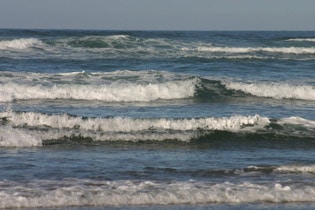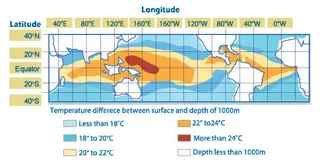
Ocean Thermal Energy Conversion
How Does Ocean Thermal Energy Conversion Work
![]() As well as geothermal sources of energy, we can also use the thermal energy in our oceans. Ocean Thermal Energy Conversion or just simply “OTEC”, is another marine based technology that extracts the potential energy stored in the worlds oceans using the various temperature layers in the water.
As well as geothermal sources of energy, we can also use the thermal energy in our oceans. Ocean Thermal Energy Conversion or just simply “OTEC”, is another marine based technology that extracts the potential energy stored in the worlds oceans using the various temperature layers in the water.
The worlds oceans are considered to be one of the most powerful sources of energy we have with the water flowing around the seas and oceans in the form of tides, waves and currents containing vast amounts of untapped energy. But as well as the well known wave and tidal power sources, the water within the oceans has the immense capacity to absorb and hold heat.
The ocean can be thought of as one large solar panel being heated up everyday of the year by the sun and on an average day, the water near the surface absorbs huge amounts of thermal heat from the rays of the sun.
So on average, the oceans warm up gaining energy during summer and cool down losing energy to the atmosphere during the winter. As the seas and oceans cover over 70% of the Earth surface it only makes sense to try and capture this thermal energy stored within the oceans, and Ocean Thermal Energy Conversion allows us to do just that.

Ocean thermal energy conversion, (OTEC) is another form of ocean based energy production. OTEC works by using the difference in temperature between the oceans surface water near to the sun and the cold water at much deeper levels to run a heat engine and generator providing a clean source of energy.
The surface layers of the tropical oceans above a depth of 100m contain vast amounts of warm water that is held constant at a temperature of about 27oC, around 80oF by the effects of absorption of the solar heat from the sun balanced by the loss of heat from the water by convection and evaporation caused by the effects of the wind and the waves.
Below this warm surface layer where the suns rays cannot penetrate, the oceans water becomes colder as the depth increases until at about 3,300 feet (1 kilometre) down the temperature of the water drops to about 3.0oC (38oF). Continuing down below this depth, the deep layer, the water temperature drops only a few degrees further until it reaches the ocean floor. Thus, a huge reservoir of very cold water exists below at depths greater than 3,300 feet.
The result of this is that the oceans contain two distinct physical layers of temperature due to the density of the water. The warm water layer being located at the surface as it is less dense where as the colder water below a depth of 3300 feet, (1,000m) is more dense keeping it at the bottom of the ocean. Then we can see that a temperature difference of about 22 to 25 degrees Celsius (40 to 45 degrees Fahrenheit) exists between the surface of the oceans and the ocean floor.
This temperature difference exists constantly throughout the year especially in the tropical oceans were the depth exceeds 3,300 feet or 1,000m with only a few variations in temperature due to the seasonal effects of the weather. Ocean thermal energy conversion (OTEC) processes uses this temperature difference for evaporation and condensing to operate a type of heat engine and produce electric power.
Just like geothermal-energy, the amount of thermal energy extracted from this temperature difference within the ocean is dependent upon the efficiency of the type of thermal system used. Currently there are three basic ocean thermal energy conversion systems available that exploit the natural temperature difference between the surface and the depths of the ocean and these are: “Open-cycle OTEC”, “Closed-cycle OTEC” and hybrid “OTEC”.
Types of Ocean Thermal Energy Conversion Techniques
- Open-cycle OTEC – An open-cycle ocean thermal energy conversion system uses the actual warm seawater to make energy as the driving fluid for the heat exchanger. Warm surface seawater is pumped into a low pressure (vacuum) chamber where the waters boiling point is lowered as a result of the vacuum converting it into steam. The steam drives the low pressure turbine and generator to create electricity. Cold deep seawater is then used to condensed the steam vapour back into liquid form before being discharged back into the ocean as it is not a potential threat to the environment.
Because the warm seawater is evaporated into a steam using a vacuum, the seawater becomes desalinated and turning it into pure fresh water. This is a major advantage to this type of open system as it can provide fresh drinking water to local communities. However there are several disadvantages to this type of vacuum based system. The first one being that the OTEC system must be carefully sealed to prevent leakage into the system of atmospheric air and destroying the vacuum. - Closed-cycle OTEC – A closed-cycle ocean thermal energy conversion system uses a gas or liquid working fluid with a low boiling point, usually propane or ammonia, in a closed and sealed circuit to rotate a turbine. Warm surface ocean water is pumped into an evaporator where the liquid ammonia is pressurized.
This pressure causes the ammonia to boil and the resulting vapour used to drive an electrical generator. Cold deep ocean water is brought up from the depths and pumped through the other side of a heat exchanger, causing the ammonia vapour to condensate back into a liquid. The liquid ammonia is then pressurized again by a pump and the cycle starts all over again. - Hybrid OTEC – A hybrid-cycle ocean thermal energy conversion system contains features from both the above systems using both seawater and a working fluid, usually ammonia. In the hybrid OTEC system, warm seawater is vaporized into steam, similar to the open-cycle in a vacuum vessel.
The ammonia is then physically mixed with the warm seawater and the mixed vapours are used to drive the turbine producing energy. The evaporated ammonia is then separated from the steam/water and re-condensed with the cold temperature and re-introduced back into the closed loop cycle. The advantage of the hybrid system is that it improves the efficiency of the system.
Ocean thermal energy conversion technology has many benefits to the environment offering a potential source of reliable renewable energy that creates no harmful emissions. OTEC is a source of clean, renewable energy which harnesses the seawater for electricity generation and as it operates using the oceans water, its source of fuel, the oceans water, is abundant and almost unlimited. One main advantages of an OTEC system is that it can provide more than just electricity.
The evaporation process of turning the sea water into steam can also be used to generate hydrogen gas, one of the main elements of water for use in powering hybrid vehicles as well as condensing the steam back to produce clean water for both drinking and agriculture. As the deep sea water brought up from the depths is very cold it can be piped ashore for use in refrigeration, air conditioning and cooling of local buildings.
However, there are some disadvantages of ocean thermal energy conversion which include the high capital cost of installing a rig out at sea and being an ocean based technology, it has the potential for damage and destruction of the equipment from the stormy and hostile ocean environment it operates within.
Another problem with OTEC is the potential for harmful working fluids and liquid substances that could leak into the ocean if the sealed pipes were ever damaged as well as the habitat disruption in the surrounding ocean due to the installation of these pipes, ducting and rigs.
Ocean Thermal Energy Conversion, (OTEC) has a long way to go before a full-scale implementation of the technology can become a reality. OTEC plants do not consume the Earth’s natural fossil fuel resources and do not produce harmful environmental pollutants such as carbon dioxide and methane as a result of combustion with mini OTEC plants operating around the world showing that OTEC systems will one day become a feasible, efficient and renewable source of energy as the technology improves.
For more information about “Ocean Thermal Energy” and how it uses the temperature difference of the oceans waters to generate electricity, or to explore the advantages and disadvantages of OTEC systems on the environment, then Click Here and order your copy from Amazon today and learn more about ocean thermal energy and the various energy harvesting technologies available.










Please Speak up!
We hope this Ocean Thermal Energy Conversion Tutorial was useful and informative for you. Are you ready to share your thoughts
and experience with us and many others. Your comments are always welcome, just post them in the section below.
P.S. Don't forget to like, rate, and share this Alternative Energy Tutorials post. Thank you for using our website.